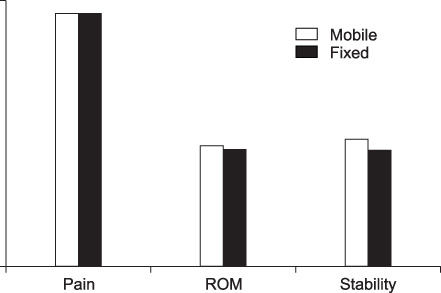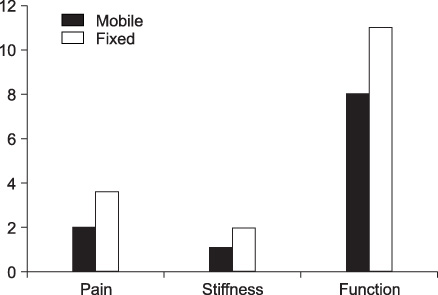J Korean Orthop Assoc.
2008 Apr;43(2):200-206. 10.4055/jkoa.2008.43.2.200.
Comparision between Mobile Bearing and Fixed Bearing T.K.A. in the Same Patient
- Affiliations
-
- 1Department of Orthopaedic Surgery, Yeung Nam University Hospital, Daegu, Korea. dclee@med.yu.ac.kr
- KMID: 2106440
- DOI: http://doi.org/10.4055/jkoa.2008.43.2.200
Abstract
-
PURPOSE: To evaluate the radiological and clinical results including the patient's satisfaction after total knee arthroplasty (TKA) using two differently designed system for both knees in the same patient.
MATERIALS AND METHODS
From January 2002 to January 2003, thirty-two bilateral TKAs were prospectively performed using two differently designed systems. One side TKA was performed using a mobile bearing (PFC RP, Dupey) system, and the other side was performed using a fixed bearing system (PFC, Dupey). All 32 patients were followed up for an average of 51.4 months. The mean age of the study group was 67 years (range 54-75). The clinical results were evaluated from the Knee Score, WOMAC score for the patient's satisfaction and range of motion. Radiological analysis including the tibiofemoral angle was also carried out. An independent T-test was used for statistical analysis.
RESULTS
The preoperative average knee score improved to 87.3 from 42.5 in the mobile bearing group and to 86 from 39 in the fixed bearing group respectively. The preoperative average WOMAC score decreased to 11.2 from 84.9 in the mobile bearing group and to 16 from 85.5 in the fixed bearing group. The average preoperative range of knee motion improved to 114.5degrees from 104.5degrees in the mobile bearing group and to 113.8degrees from 104.7degrees in the fixed bearing group. The average preoperative tibiofemoral angle improved to 5.3degrees valgus form 4.5degrees varus in the mobile bearing group and to 6degrees valgus from 3.8degrees varus in the fixed bearing group. The only result statistically significant was the WOMAC score (p<0.05).
CONCLUSION
The two differently designed TKA system produce similar outcomes except for the subjective satisfaction in the mid-term clinical and radiological evaluation.
Figure
Reference
-
1. Bartel DL, Burstein AH, Toda MD, Edwards DL. The effect of conformity and plastic thickness on contact stresses in metal-backed plastic implants. J Biomech Eng. 1985. 107:193–199.
Article2. Bellamy N. Pain assessment in osteoarthritis: experience with the WOMAC osteoarthritis index. Semin Arthritis Reum. 1989. 18:4 Suppl 2. 14–17.
Article3. Buechel FF. New Jersey low-contact-stress (LCS) knee replacement system. Clin Orthop Relat Res. 1991. 264:309–311.4. Buechel FF, Pappas MJ. Long-term survivorship analysis of cruciate-sparing versus cruciate-sacrificing knee prostheses using meniscal bearings. Clin Orthop Relat Res. 1990. 260:162–169.
Article5. Callaghan JJ, Squire MW, Goetz DD, Sullivan PM, Johnston RC. Cemented rotating-platform total knee replacement. A nine to twelve-year follow-up study. J Bone Joint Surg Am. 2000. 82:705–711.6. Chiu KY, Ng TP, Tang WM, Lam P. Bilateral total knee arthroplasty: one mobile-bearing and one fixed-bearing. J Orthop Surg (Hong Kong). 2001. 9:45–50.
Article7. Christopher JV, Mark EE, Scott WN, Insall JN. Mobile bearing in primary knee arthroplasty. J Am Acad Orthop Surg. 2001. 9:355–364.8. Darryl DD, Micheal T, Andrew GU, Clifford WC. Comparison between the kinematics of fixed and rotating bearing knee prostheses. Clin Orthop Relat Res. 2000. 380:151–157.9. Ewald FC. The knee society total knee arthroplasty roentgenographic evaluation and scoring system. Clin Orthop Relat Res. 1989. 248:9–12.
Article10. Font-Rodriguez DE, Scuderi GR, Insall JN. Survivorship of cemented total knee arthroplasty. Clin Orthop Relat Res. 1997. 345:79–86.
Article11. Gill GS, Chan KC, Mills DM. 5- to 18-year follow-up study of cemented total knee arthroplasty for patients 55 years old or younger. J Arthroplasty. 1997. 121:49–54.
Article12. Insall JN, Dorr LD, Scott RD, Scott WN. Rationale of the Knee Society clinical rating system. Clin Orthop Relat Res. 1989. 248:13–14.
Article13. Lee DC, Kim DH, Scott RD, Suthers K. Intraoperative flexion against gravity as indication of ultimate range of motion individual cases after total knee arthroplasty. J Arthroplasty. 1998. 5:500–503.14. Matsuda S, Whiteside LA, White SE, McCarthy DS. Knee stability in meniscal bearing total knee arthroplasty. J Arthroplasty. 1999. 14:82–90.
Article15. Sorrells RB. The rotating platform mobile bearing TKA. Orthopaedics. 1996. 19:793–796.
Article16. O'Connor JJ, Goodfellow JW. Theory and practice of meniscal knee replacement: designing against wear. Proc Inst Mech Eng. 1996. 210:217–222.17. Walker PS, Sathasivam S. Controlling the motion of total knee replacements using intercondylar guide surfaces. J Orthop Res. 2000. 18:48–55.
Article18. Weaver JK, Derkash RS, Greenwald AS. Difficulties with bearing dislocation and breakage using a movable bearing total knee replacement system. Clin Orthop Relat Res. 1993. 290:244–252.
Article19. Werner F, Foster D, Murray DG. The influence of design on the transmission of torque across knee prostheses. J Bone Joint Surg Am. 1978. 60:342–348.
Article20. Woolson ST, Northrop GD. Mobile- vs. fixed-bearing total knee arthroplasty: a clinical and radiologic study. J Arthroplasy. 2004. 19:135–140.
- Full Text Links
- Actions
-
Cited
- CITED
-
- Close
- Share
- Similar articles
-
- A Comparison of Mobile-bearing and Fixed-bearing Total Knee Arthroplasties in Osteoarthritic Patients
- Mobile Bearing Subluxation after Unicompartmental Knee Arthroplasty Treated by Arthroscopy : A Case Report
- Dislocation of Tibial Insert after Fixed Bearing TKA using Minimal Invasive Surgery: A Case Report
- Comparison of the Mobile-bearing and Fixed-bearing Designs for High Flexion Total Knee Arthroplasty
- Comparison of Mobile-Bearing and Fixed-Bearing Designs in High Flexion Total Knee Arthroplasty: Using a Navigation System



